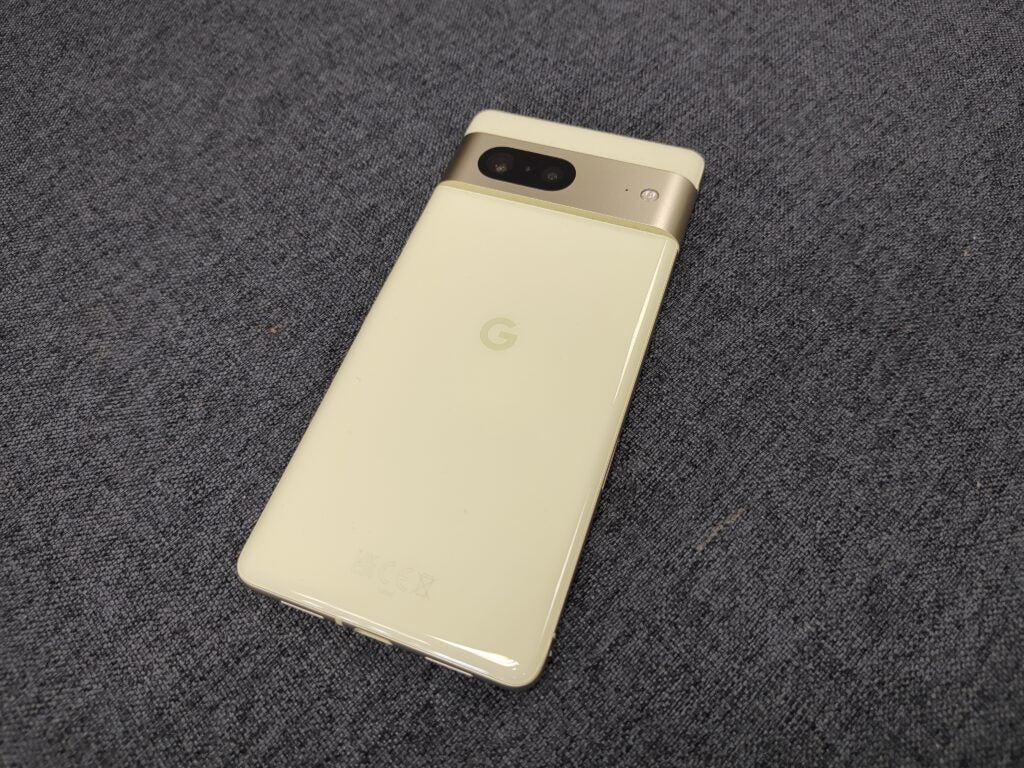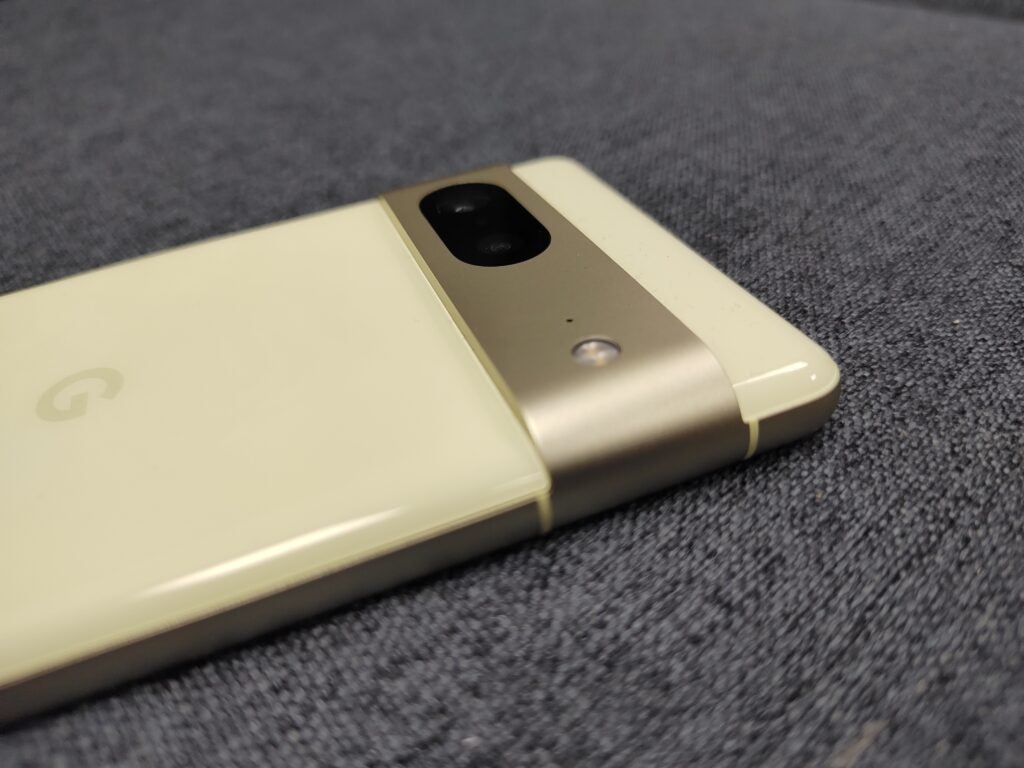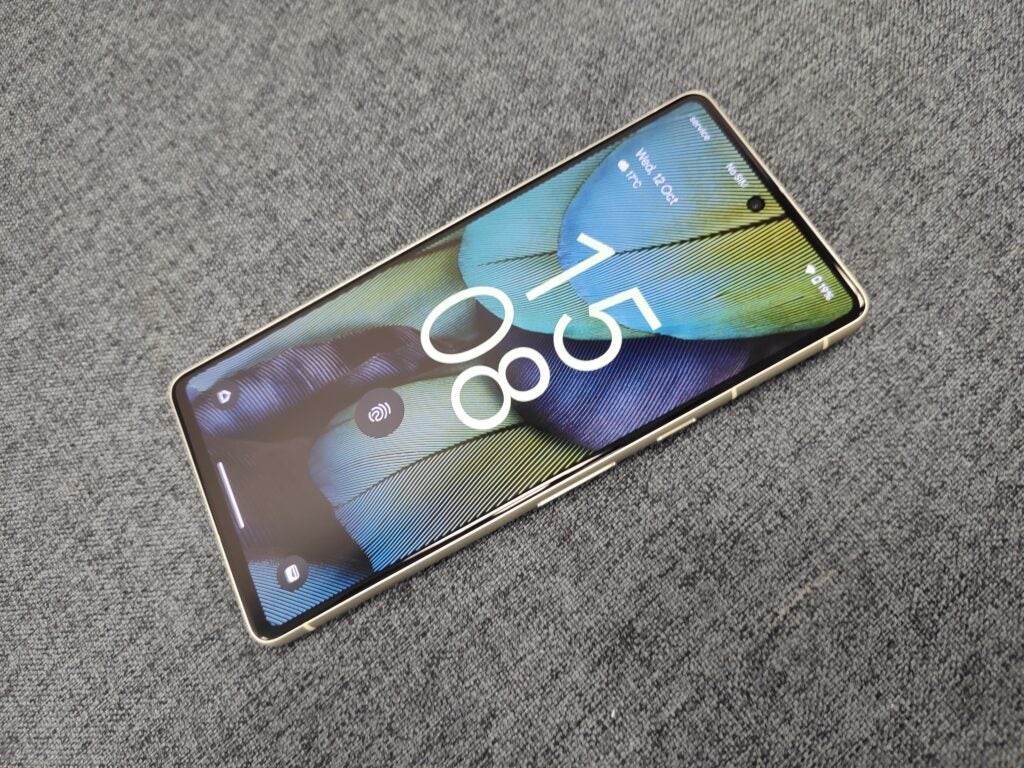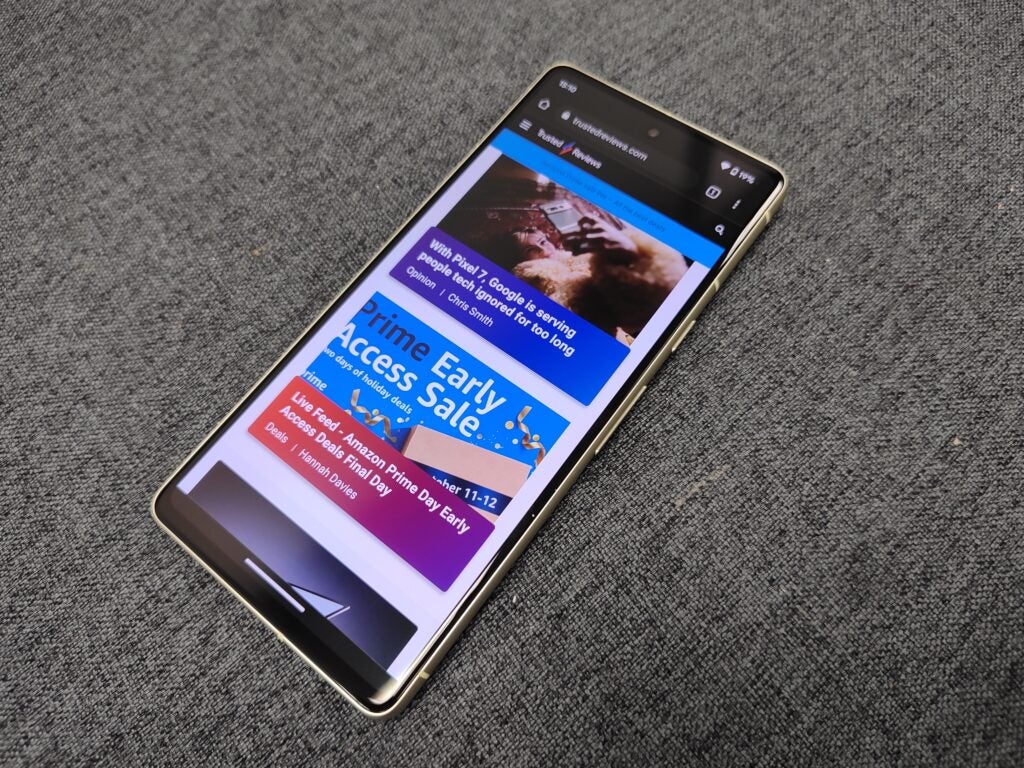Google’s newest smartphone seems similar to its predecessor, but has it got some crafty new tricks up its sleeve? Here are our first impressions of the handset.
-
Dual camera systemThe Pixel 7 has a similar dual-sensor set-up to the highly-rated Pixel 6 -
Unique designThis handset’s appearance, and especially the metallic camera bar, is likely to turn heads -
Android 13This is one of the first handsets to run Google’s latest operating system out of the box
Availability
- UKRRP: £599
- USARRP: $599
- EuropeRRP: €649
- CanadaTBC
- AustraliaRRP: AU$999
Introduction
Google has won a strong reputation for delivering phones that look classy, take excellent photos, and have silky software skills as well. It’s not hard to see why they’ve won over a crowd of admirers.
However, that’s not to say that the Pixel series has been perfect; and with the launch of the Pixel 7, which looks different but offers similar specifications to the Pixel 6, it’s worth wondering whether this device is really worth the upgrade or whether it just offers an extra touch of finesse.
After a few days’ experience with the phone, here’s what I thought of it.
Design and Screen
- Classy-looking design
- Bulky camera bump
- Good, not great, screen
The Pixel 7 is a strikingly handsome phone, at least from a distance. Available in three fetching colours (Obsidian, Snow, and Lemongrass – the colour of our review handset), the phones look vibrant and premium, with a classy gloss finish that doesn’t show up fingerprints but does feel delightfully smooth to the touch.

These colours are complimented by a large camera bar across the back, this time with a metallic finish which certainly looks a tad more alluring than the black bar of the previous generation of Pixels. However, while it does give a premium touch to the appearance, I’m not entirely enamoured by its execution here.

For one thing, the edges are straight and therefore almost sharp to the touch; it’s not smoothly integrated into the back of the phone like the Oppo Find X5 Pro for instance, which adds a level of comfort when you’re handling the phone.
The flat edges also mean that it can act like a little shelf for dust, which can settle above the bar, and it cannot sit flat on a tabletop either, protruding significantly. While it looks good from a distance then, I felt that this camera bar could have been better designed when thinking of actual users handling the phone.
As with previous generations of Pixel smartphones, there’s no 3.5mm headphone jack or SD card slot (hardly surprising), but it is at least robust thanks to its high IP68 rating and the Gorilla Glass Victus construction of the front and rear glass panels.

The AMOLED screen measures 6.3-inches, so it’s not as large as that of the Pixel 7 Pro but it is still sizeable enough. I didn’t particularly find myself wanting more display space and yet it still felt manageable to hold.
The resolution is 1080×2400 and is perfectly sharp enough for the content you’ll be watching, and it’s also got HDR10+ support as well to add a bit of extra flair to the colours when you’re watching supported content on platforms such as Netflix.
However, one potential sticking point for the display is its refresh rate; this is still stuck at 90Hz rather than the 120Hz you might have been expecting, so it cannot offer the same top-tier smoothness that we’ve witnessed on more premium smartphones this year, such as the Samsung Galaxy S22 or the OnePlus 10T.
An extra thing to note is that the Pixel 7 does deliver a well-integrated and simple always-on display.
Camera
- 50-megapixel main camera
- 12-megapixel ultrawide
- 10.8-megapixel selfie camera
As with every generation of Pixel, the excitement is most keenly focused on its camera abilities.
However, at least according to the spec sheets, this is arguably where there has been the least change of all. Once again there’s a 50-megapixel main camera and it’s joined with a 12-megapixel ultrawide sensor. There’s no telephoto here, a feature reserved for the Pixel 7 Pro, but you can use digital zoom to get closer to your subjects when using the main camera.
We’ve not yet tried the Pixel 7’s camera under all conditions, as we will have for the full review, but for the time being, I have been very satisfied with the shots that I’ve taken.
With a natural-looking colour palette, the detail is really strong so that close-up subjects especially can look very striking. We’ve come to expect camera excellence from Pixel smartphones, and it doesn’t look like the Pixel 7 will be any different, especially as it gives you access to handy editing tricks such as Magic Eraser, to get rid of intrusive objects from your pictures.
Flip it over, and you do have some new hardware to play with; a 10.8-megapixel selfie camera, which can now support 4K video recording. In my experience of using this camera, selfies seemed detailed and warm, while the bokeh effect was performed very well too; you’ll likely approve of the photos you can take of yourself with this handset.
Performance
- Tensor G2 chipset
- Android 13 software
Last year saw Google unveiling its own-brand silicon for the first time, on board the Pixel 6 series. This was a big step for the brand, and we were certainly impressed by its capabilities in the image post-processing game, but the benchmarking scores showed that the CPU and GPU weren’t quite up to the peak Android performers running on Qualcomm’s latest Snapdragon gear.
From my time with the Pixel 7, I have been perfectly satisfied with the performance of Tensor G2, this time around not encountering the software bugs that were unfortunately present on its predecessor. For my part, I didn’t notice any lag or hiccups when using a variety of daily apps and multi-tasking between them.
There’s also an array of connectivity tech here, from 5G mobile data to Bluetooth 5.2 to NFC, for all those extra conveniences, and you can install an eSIM and physical SIM on the device as well.

Google’s Android 13 is present here, and it has been a pleasure to use this software while I’ve had the phone. Though not drastically different to Android 12 in its execution, the classic Pixel experience remains intact with this device, which means an uncluttered and relatively intuitive experience, enriched by a couple of Pixel-only features such as the aforementioned Magic Eraser, along with tools such as Live Translate which allows workable cross-language communication.
Battery Life
- 4355mAh cell
- 30W fast-charging
- No in-box charger
While the Pixel 6 tended to get us through a busy day, albeit with little battery left to spare, I had been hoping that this capability had been improved somewhat on the newer generation, especially bearing in mind that its predecessor’s cell had drained especially quickly during gaming; however, there’s actually been a minuscule decrease in the listed capacity, down to 4335mAh from 4614mAh.

In my brief time using the phone, it has delivered me a day of battery life with no problems, but I intend to really put it through its paces with more a more demanding schedule and mix of different activities before giving my final verdict on its capability.
When charging back up again, you can rely on 30W power, though you’ll have to supply your own charger for this as there isn’t one in the box. It also supports 20W wireless charging, which can be a potential convenience if you prefer juicing your phone back up on a stand or a mat rather than going through the cable rigmarole.
Early Impressions
Even in a short time of using it, the Pixel 7 certainly has managed to charm us quite a bit. The design looks good and, importantly, quite different from its peers at a time when smartphones increasingly resemble each other, while our initial impressions of the camera are very positive as well. As expected, this handset also offers us the trademark stripped-down software experience so that you get Android 13 at its purest, and we haven’t encountered the bugs that bedeviled the Pixel 6 at launch.
However, it does have to be noted that there really aren’t that many changes here when compared directly with the Pixel 6, and so with that in mind we’ll be paying particular attention to the device’s performance and battery life when completing the full review, as these were two potential points for improvements from last time around. What’s more, despite its flash appearance, the flat-edged camera bump hasn’t really won me over as an ergonomic improvement for the user.
FAQs
The Pixel 7 is available in Obsidian, Snow, and Lemongrass (as shown in the review)
Yes, it has a high IP68 rating, meaning that it offers strong resistance against potential water or dust ingress
Yes, as long as you’ve got a compatible SIM card and network coverage then you’ll get 5G data speeds with this phone
Google Pixel 7 specifications
Jargon buster
IP68
The most popular and useful level of water resistance. Usually means a device can withstand dust, dirt and sand and be submerged in 1.5m of water for 30m however this can sometimes vary. Read more in our IP68 guide for more.
OLED
Organic Light Emitting Diode is panel technology that allows each individual pixel to produce light rather than relying on a backlight. This enables the screen to accurately display blacks by turning off the pixel, resulting in improved contrast compared to conventional LCD panels.
Google’s newest smartphone seems similar to its predecessor, but has it got some crafty new tricks up its sleeve? Here are our first impressions of the handset.
-
Dual camera systemThe Pixel 7 has a similar dual-sensor set-up to the highly-rated Pixel 6 -
Unique designThis handset’s appearance, and especially the metallic camera bar, is likely to turn heads -
Android 13This is one of the first handsets to run Google’s latest operating system out of the box
Availability
- UKRRP: £599
- USARRP: $599
- EuropeRRP: €649
- CanadaTBC
- AustraliaRRP: AU$999
Introduction
Google has won a strong reputation for delivering phones that look classy, take excellent photos, and have silky software skills as well. It’s not hard to see why they’ve won over a crowd of admirers.
However, that’s not to say that the Pixel series has been perfect; and with the launch of the Pixel 7, which looks different but offers similar specifications to the Pixel 6, it’s worth wondering whether this device is really worth the upgrade or whether it just offers an extra touch of finesse.
After a few days’ experience with the phone, here’s what I thought of it.
Design and Screen
- Classy-looking design
- Bulky camera bump
- Good, not great, screen
The Pixel 7 is a strikingly handsome phone, at least from a distance. Available in three fetching colours (Obsidian, Snow, and Lemongrass – the colour of our review handset), the phones look vibrant and premium, with a classy gloss finish that doesn’t show up fingerprints but does feel delightfully smooth to the touch.

These colours are complimented by a large camera bar across the back, this time with a metallic finish which certainly looks a tad more alluring than the black bar of the previous generation of Pixels. However, while it does give a premium touch to the appearance, I’m not entirely enamoured by its execution here.

For one thing, the edges are straight and therefore almost sharp to the touch; it’s not smoothly integrated into the back of the phone like the Oppo Find X5 Pro for instance, which adds a level of comfort when you’re handling the phone.
The flat edges also mean that it can act like a little shelf for dust, which can settle above the bar, and it cannot sit flat on a tabletop either, protruding significantly. While it looks good from a distance then, I felt that this camera bar could have been better designed when thinking of actual users handling the phone.
As with previous generations of Pixel smartphones, there’s no 3.5mm headphone jack or SD card slot (hardly surprising), but it is at least robust thanks to its high IP68 rating and the Gorilla Glass Victus construction of the front and rear glass panels.

The AMOLED screen measures 6.3-inches, so it’s not as large as that of the Pixel 7 Pro but it is still sizeable enough. I didn’t particularly find myself wanting more display space and yet it still felt manageable to hold.
The resolution is 1080×2400 and is perfectly sharp enough for the content you’ll be watching, and it’s also got HDR10+ support as well to add a bit of extra flair to the colours when you’re watching supported content on platforms such as Netflix.
However, one potential sticking point for the display is its refresh rate; this is still stuck at 90Hz rather than the 120Hz you might have been expecting, so it cannot offer the same top-tier smoothness that we’ve witnessed on more premium smartphones this year, such as the Samsung Galaxy S22 or the OnePlus 10T.
An extra thing to note is that the Pixel 7 does deliver a well-integrated and simple always-on display.
Camera
- 50-megapixel main camera
- 12-megapixel ultrawide
- 10.8-megapixel selfie camera
As with every generation of Pixel, the excitement is most keenly focused on its camera abilities.
However, at least according to the spec sheets, this is arguably where there has been the least change of all. Once again there’s a 50-megapixel main camera and it’s joined with a 12-megapixel ultrawide sensor. There’s no telephoto here, a feature reserved for the Pixel 7 Pro, but you can use digital zoom to get closer to your subjects when using the main camera.
We’ve not yet tried the Pixel 7’s camera under all conditions, as we will have for the full review, but for the time being, I have been very satisfied with the shots that I’ve taken.
With a natural-looking colour palette, the detail is really strong so that close-up subjects especially can look very striking. We’ve come to expect camera excellence from Pixel smartphones, and it doesn’t look like the Pixel 7 will be any different, especially as it gives you access to handy editing tricks such as Magic Eraser, to get rid of intrusive objects from your pictures.
Flip it over, and you do have some new hardware to play with; a 10.8-megapixel selfie camera, which can now support 4K video recording. In my experience of using this camera, selfies seemed detailed and warm, while the bokeh effect was performed very well too; you’ll likely approve of the photos you can take of yourself with this handset.
Performance
- Tensor G2 chipset
- Android 13 software
Last year saw Google unveiling its own-brand silicon for the first time, on board the Pixel 6 series. This was a big step for the brand, and we were certainly impressed by its capabilities in the image post-processing game, but the benchmarking scores showed that the CPU and GPU weren’t quite up to the peak Android performers running on Qualcomm’s latest Snapdragon gear.
From my time with the Pixel 7, I have been perfectly satisfied with the performance of Tensor G2, this time around not encountering the software bugs that were unfortunately present on its predecessor. For my part, I didn’t notice any lag or hiccups when using a variety of daily apps and multi-tasking between them.
There’s also an array of connectivity tech here, from 5G mobile data to Bluetooth 5.2 to NFC, for all those extra conveniences, and you can install an eSIM and physical SIM on the device as well.

Google’s Android 13 is present here, and it has been a pleasure to use this software while I’ve had the phone. Though not drastically different to Android 12 in its execution, the classic Pixel experience remains intact with this device, which means an uncluttered and relatively intuitive experience, enriched by a couple of Pixel-only features such as the aforementioned Magic Eraser, along with tools such as Live Translate which allows workable cross-language communication.
Battery Life
- 4355mAh cell
- 30W fast-charging
- No in-box charger
While the Pixel 6 tended to get us through a busy day, albeit with little battery left to spare, I had been hoping that this capability had been improved somewhat on the newer generation, especially bearing in mind that its predecessor’s cell had drained especially quickly during gaming; however, there’s actually been a minuscule decrease in the listed capacity, down to 4335mAh from 4614mAh.

In my brief time using the phone, it has delivered me a day of battery life with no problems, but I intend to really put it through its paces with more a more demanding schedule and mix of different activities before giving my final verdict on its capability.
When charging back up again, you can rely on 30W power, though you’ll have to supply your own charger for this as there isn’t one in the box. It also supports 20W wireless charging, which can be a potential convenience if you prefer juicing your phone back up on a stand or a mat rather than going through the cable rigmarole.
Early Impressions
Even in a short time of using it, the Pixel 7 certainly has managed to charm us quite a bit. The design looks good and, importantly, quite different from its peers at a time when smartphones increasingly resemble each other, while our initial impressions of the camera are very positive as well. As expected, this handset also offers us the trademark stripped-down software experience so that you get Android 13 at its purest, and we haven’t encountered the bugs that bedeviled the Pixel 6 at launch.
However, it does have to be noted that there really aren’t that many changes here when compared directly with the Pixel 6, and so with that in mind we’ll be paying particular attention to the device’s performance and battery life when completing the full review, as these were two potential points for improvements from last time around. What’s more, despite its flash appearance, the flat-edged camera bump hasn’t really won me over as an ergonomic improvement for the user.
FAQs
The Pixel 7 is available in Obsidian, Snow, and Lemongrass (as shown in the review)
Yes, it has a high IP68 rating, meaning that it offers strong resistance against potential water or dust ingress
Yes, as long as you’ve got a compatible SIM card and network coverage then you’ll get 5G data speeds with this phone
Google Pixel 7 specifications
Jargon buster
IP68
The most popular and useful level of water resistance. Usually means a device can withstand dust, dirt and sand and be submerged in 1.5m of water for 30m however this can sometimes vary. Read more in our IP68 guide for more.
OLED
Organic Light Emitting Diode is panel technology that allows each individual pixel to produce light rather than relying on a backlight. This enables the screen to accurately display blacks by turning off the pixel, resulting in improved contrast compared to conventional LCD panels.























